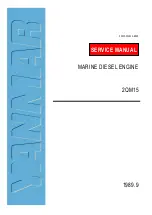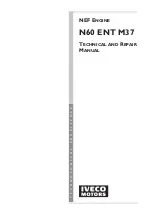
Wren 44 TurboProp Users Manual. Copyright Wren Turbines Ltd February 2008 Page 17
Propeller Selection and Balancing
Some examples may help to answer questions about choice of propeller:
1)
Slow flying “glider-tug” 2.5m span. Ideal propeller is a large diameter around 560-610
(22”-24”) and shallow pitch around 200 – 250 (8”-10”). If there is a problem with
ground clearance with the larger diameter, then a 3-bladed one can be selected. In
this case a diameter of around 50mm (2”) smaller in diameter - 510 (20”) would be
suitable, with a 250 or 200 (10” or 8”) pitch.
2)
Fast flying sports type “Extra” or similar 2.20-2.5m span. Ideal propeller is 560 x 305
(22” x 12”) 2-blade or 510 x 305 (20” x 12”) 3-bladed. The larger pitch and smaller
rpm allows a higher propeller rpm and corresponding high forward airspeed.
3)
Reasonably fast scale type “Tucano” or similar, 2-2.5m span scale type. Ideal size is
560 x 305 (22” x 12”) 3-bladed. The larger diameter and pitch enables plenty of thrust
for good forward speed with a quiet operation and scale appearance.
It is worth noting that the thrust measures are
static
figures, the dynamic thrust (when the aircraft
is in flight) will reduce as aircraft airspeed increases and is a function of all propeller driven
aircraft. However, it is worth reminding that the thrust on a turbo-prop falls off more gradually than
an I/C engine due to the fact that as the propeller load reduces due to forward speed
(“unloading”) it’s rpm rises to balance the torque supplied. This feature enables turbo-prop
powered aircraft to achieve a higher forward speed than the static rpm suggests, or the same
speed achieved for a reduced throttle setting.
Ultimate forward speed, it should be reminded is mainly a function of forward thrust against
airframe drag. A slippery airframe will result in far greater performance on even modest power
levels, whereas a large draggy airframe may fly slowly on even exceptional power.
Propeller Balancing
It is imperative that propellers used on the turbo-prop are balanced to a fine degree as the engine
is produced utilising a high standard of balance on assembly. A standard propeller, new and just
out of the box is very likely to be significantly out of balance and using it in this condition can
cause damage to the engine through excessive and rapid wear on bearing journals and potential
fatigue failures of the fuel system in the engine. Such imbalance can be easily seen when an
engine is running by the tail fin or tail surfaces trembling.
Balancing is equally important if you plan to install a spinner,
particularly if it is one that has an aluminium backplate. Such
spinners can have a similar severe effect on the smoothness of the
unit and must receive similar care to the propeller.
Simple and highly effective propeller balancing units based on a pair
of magnets have been available commercially for many years (see
the “Top Flight” one at left), or alternatively those with facilities can
produce their own. Imbalance correction is normally a combination
of scraping the heavy blade evenly towards the end of the blade –
never at the root as this can weaken it. Alternatively, light sprays of
clear fuel proofer on the light blade will achieve the same result.
Important -
No attempt should be made to add material,
lead shot or coloured sticky tape to the light blade as this is sure to fly off later and if you are
lucky it might not to hurt someone, but the resulting out-of-balance running could cause major
engine damage. If this happened in the air you would not know until it was too late. The warranty
will not cover you for such damage.
















































